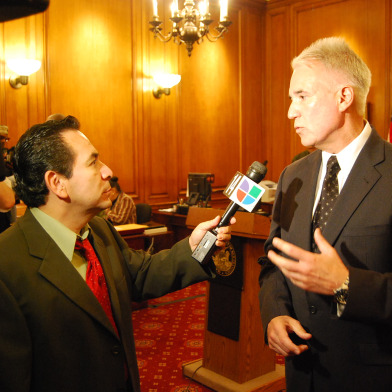 “Synergy” Includes Community Court, Exile of Rival to Mayor’s Office
“Synergy” Includes Community Court, Exile of Rival to Mayor’s Office
In one fell swoop Wednesday, San Francisco District Attorney George Gascón streamlined what is by reputation one of the city’s least efficient departments and eliminated one of his chief competitors for a full four-year term as DA in the November election.
Paul Henderson, Gascón’s former chief of administration who declared his candidacy for the DA position in November, has accepted a job with the Mayor’s Office of Criminal Justice, the Examiner reported earlier today. His post has been eliminated; so too were the other chief deputy positions, Gascón told a Hall of Justice press conference on Wednesday.
Instead, Gascón will have but one chief of staff: Cristine DeBerry, who until Tuesday served as Mayor Ed Lee’s chief of staff. An attorney by training, DeBerry will not be responsible for any court work or case management. That will be up to former David Pfeiffer and Sharon Woo, who will respectively head up the special operations (white collar crime, investigations and training) and operations (actual court work) departments. The jobs of Pfeiffer, the former Chief Assistant District Attorney, and Woo, former Chief of the Criminal Division, appear to have changed mostly in title.
No layoffs or other fiscal changes are immediately in store for the department, which has a $39 million annual budget, Gascón said. However, if he is forced to trim his budget by 10 percent — the figure by which all city departments must cut budget under direction from the Mayor’s Office — he will be forced to lay off the equivalent of 18 prosecutors, he said.
And he can’t possibly do that with the horrible backlogs facing his shop: right now, it takes 3-4 months to process most felony cases, up to 3 1/2 years to bring a murder case to trial, and only one out of every 26 misdemeanor cases is ever prosecuted, Gascón said today.
To stem that tide somewhat, the DA will roll out its community court system sometime in the next two months. A community court “could be anywhere — it could be that bench,” said Gascón, pointing to a piece of furniture in the Hall of Justice’s hearing room.
These courts will consist of nothing more than the accuser, the accused, and three members of the public assigned to mediate between the two and cook up a solution, be it community service, restitution, or something else.
That would mean a misdemeanor case would cost $300 to bring to justice, instead of the $1200-$1300 it would cost in the court system.
Other DA-funded programs, like the Tenderloin’s Community Justice Center, will be untouched, Gascón said.
But what cases will the DA actually prosecute? And when can the city expect homicides to be brought to court more quickly? Priority will be given to “violent” cases, Gascón said, but attention will be paid to neglected areas like consumer protection and environmental crimes, he said.
Asked specifically if he would give less priority to cases involving medical cannabis, Gascón demurred, saying each case would be judged on its merits individually. As for other reforms, Gascón pledged to form working groups within the next two months, teams that will issue recommendations and — who knows? — maybe even take a case to court.
Want more news, sent to your inbox every day? Then how about subscribing to our email newsletter? Here’s why we think you should. Come on, give it a try.









